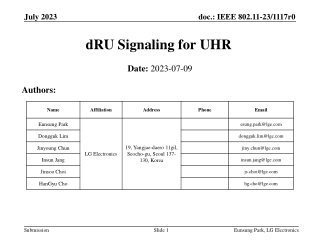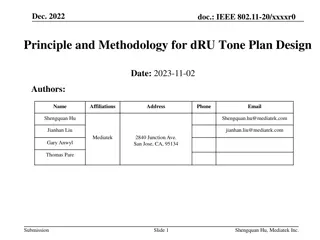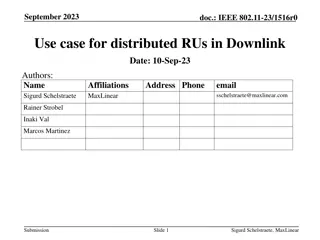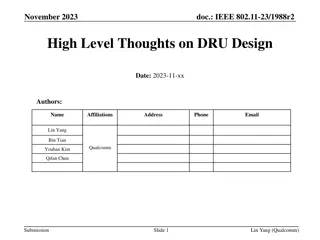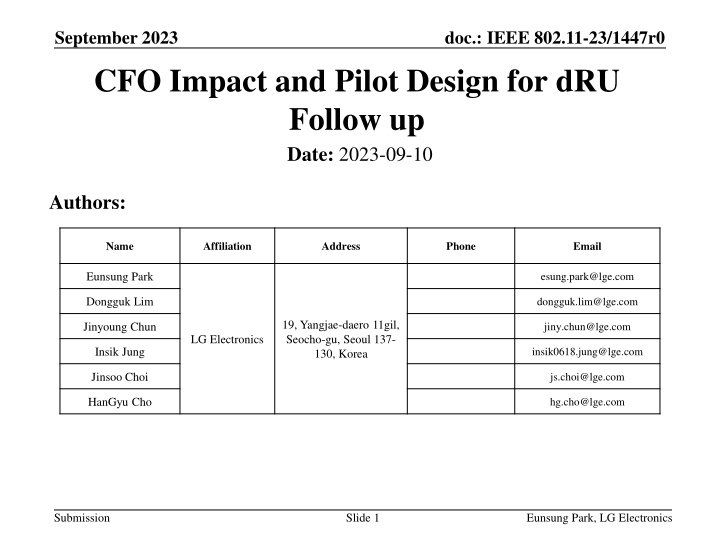
IEEE 802.11-23/1447r0 Pilot Design Methods Comparison and Alternative Approach
Explore the comparison between two pilot design methods in IEEE 802.11-23/1447r0 document, emphasizing the performance impact of residual CFO. An alternative pilot design approach is introduced for enhanced performance, backed by simulation results and responses to previous feedback. The document delves into defining new pilot positions versus maintaining conventional pilot positions, highlighting the significance of accurate residual CFO compensation for optimal results.
Download Presentation

Please find below an Image/Link to download the presentation.
The content on the website is provided AS IS for your information and personal use only. It may not be sold, licensed, or shared on other websites without obtaining consent from the author. If you encounter any issues during the download, it is possible that the publisher has removed the file from their server.
You are allowed to download the files provided on this website for personal or commercial use, subject to the condition that they are used lawfully. All files are the property of their respective owners.
The content on the website is provided AS IS for your information and personal use only. It may not be sold, licensed, or shared on other websites without obtaining consent from the author.
E N D
Presentation Transcript
September 2023 doc.: IEEE 802.11-23/1447r0 CFO Impact and Pilot Design for dRU Follow up Date: 2023-09-10 Authors: Name Affiliation Address Phone Email Eunsung Park esung.park@lge.com Dongguk Lim dongguk.lim@lge.com 19, Yangjae-daero 11gil, Seocho-gu, Seoul 137- 130, Korea Jinyoung Chun jiny.chun@lge.com LG Electronics Insik Jung insik0618.jung@lge.com Jinsoo Choi js.choi@lge.com HanGyu Cho hg.cho@lge.com Submission Slide 1 Eunsung Park, LG Electronics
September 2023 doc.: IEEE 802.11-23/1447r0 Introduction In [1], we compared two pilot design methods and investigated performance considering various values of residual CFO In this contribution, we introduce an alternative pilot design method which is based on option 2 shown in [1] and offers an improved performance In addition, we provide further simulation results and our thoughts to address comments from the last presentation Submission Slide 2 Eunsung Park, LG Electronics
September 2023 doc.: IEEE 802.11-23/1447r0 Recap on Pilot Design in [1] Option 1: define new pilot position For a 26-tone dRU, 26 distributed tones are allocated and then two tones among them are selected as pilot tones We use the 7th and 20th tones in each 26-tone dRU as the pilot tones Option 2: maintain conventional pilot position For a 26-tone dRU, 24 distributed tones are allocated as data tones and then two tones among the conventional pilot tones are additionally allotted as pilot tones The pilot tones of x-th 26-tone rRU are used as the pilot tones for x-th 26- tone dRU Submission Slide 3 Eunsung Park, LG Electronics
September 2023 doc.: IEEE 802.11-23/1447r0 Alternative Pilot Design In [1], we showed that the performance of option 2 is worse than option 1 Two pilots of each 26-tone dRU in option 2 are closely located resulting in less accurate residual CFO compensation To achieve a better performance, we employ an alternative method where two pilot tones located far enough away are selected out of the conventional ones for each 26-tone dRU Specifically, in 20 MHz, there are 18 conventional pilot tones (pilot tone index 1 ~ 18) and each pilot tone is allocated to the n-th 26-tone dRU Where n is equal to mod(pilot tone index-1, 9) + 1 Pilot tone 1 Pilot tone 2 Pilot tone 10 Pilot tone 11 Pilot tone 3 Pilot tone 12 Allocated to the 3rd 26-tone dRU Allocated to the 2nd 26-tone dRU Allocated to the 1st 26-tone dRU Submission Slide 4 Eunsung Park, LG Electronics
September 2023 doc.: IEEE 802.11-23/1447r0 Performance Comparison (1/3) We investigate PER performance for dRU with three options as well as rRU considering various residual CFO values Assumptions 20 MHz UL TB PPDU with nine 26-tone dRUs / nine 26-tone rRUs SISO under Channel D NLoS 1000 data bits per each STA MCS 0/3/5/8 with LDPC coding Residual CFO for each STA: [+rCFO rCFO +rCFO rCFO ] Different rCFO values are considered depending on the MCS level Pilot position for dRU Option 1: 7th and 20th tones in each 26-tone dRU Option 2: pilot tones of x-th 26-tone rRU for x-th 26-tone dRU Option 3: alternative pilot design in the previous slide PERs for the first 26-tone dRU and first 26-tone rRU are provided Submission Slide 5 Eunsung Park, LG Electronics
September 2023 doc.: IEEE 802.11-23/1447r0 Performance Comparison (2/3) Simulation results MCS 3 MCS3 0 10 SNR is defined as the average signal to noise power ratio per tone Note that in [1], SNR is defined as the average signal to noise power ratio in 20 MHz for the STA assigned to the first rRU / dRU rRU w 0Hz rRU w 300Hz rRU w 500Hz Op1 dRU w 0Hz Op1 dRU w 300Hz Op1 dRU w 500Hz Op2 dRU w 0Hz Op2 dRU w 300Hz Op2 dRU w 500Hz Op3 dRU w 0Hz Op3 dRU w 300Hz Op3 dRU w 500Hz -1 PER 10 PERs for MCS 0 / 5 / 8 are shown in Appendix and the trend is similar -2 10 12 14 16 18 20 22 24 SNR [dB] When rCFO = 0 Hz, dRU provides a significant performance gain dRU has a wider performance gap between with and without the residual CFO dRU still outperforms rRU even though a certain amount of residual CFO is present When rCFO > 0 Hz, Option 1 and option 3 have similar performance and offer better performance than option 2 Submission Slide 6 Eunsung Park, LG Electronics
September 2023 doc.: IEEE 802.11-23/1447r0 Performance Comparison (3/3) When there is no residual CFO, dRU achieves quite better performance than rRU, no matter what the pilot option is That is because dRU can obtain a significant frequency diversity gain As the amount of the residual CFO increases, dRU performance deteriorates much faster That is because dRU is more vulnerable to the residual CFO However, its performance is still better than that of rRU In addition, thanks to the higher transmit power for dRU, dRU performance can be further enhanced Option 1 and option 3 have similar performance and provide better performance than option 2 Even though we maintain the conventional pilot tones for dRU tone plan, we can achieve comparable performance Submission Slide 7 Eunsung Park, LG Electronics
September 2023 doc.: IEEE 802.11-23/1447r0 Received Comments (1/3) Performance with a randomly generated residual CFO Assumptions are the same except that the residual CFO for each STA is randomly generated between rCFO and +rCFO MCS3 0 10 rRU w 0Hz rRU w 300Hz rRU w 500Hz Op1 dRU w 0Hz Op1 dRU w 300Hz Op1 dRU w 500Hz Op2 dRU w 0Hz Op2 dRU w 300Hz Op2 dRU w 500Hz Op3 dRU w 0Hz Op3 dRU w 300Hz Op3 dRU w 500Hz -1 PER 10 -2 10 12 14 16 18 20 22 24 SNR [dB] The trend is similar but the gap between the cases with and without the residual CFO becomes narrower Submission Slide 8 Eunsung Park, LG Electronics
September 2023 doc.: IEEE 802.11-23/1447r0 Received Comments (2/3) Reasonable residual CFO value given SNR Basically, when a STA transmits a TB PPDU, we can assume that CFO is pre-compensated by using a DL PPDU which conveys the Trigger frame that solicits the TB PPDU Thus, the amount of the residual CFO in the TB PPDU can be affected by the condition of the channel on which the Trigger frame is transmitted (similar to the condition of the channel where TB PPDU is transmitted) E.g., CDF of the absolute value of the residual CFO after compensating the CFO in a DL PPDU at *18 dB (average SNR per tone) when considering the CFO of 20 ppm in 5 GHz SNR = 18 dB 1 Average: 447 Hz Median: 347 Hz Maximum: 2951 Hz Minimum: <1 Hz 0.9 0.8 0.7 0.6 CDF 0.5 0.4 0.3 0.2 *10 % PER is achieved for option 1 and option 3 0.1 0 0 500 1000 1500 2000 2500 3000 residual CFO [Hz] Submission Slide 9 Eunsung Park, LG Electronics
September 2023 doc.: IEEE 802.11-23/1447r0 Received Comments (3/3) Reasonable residual CFO value given SNR (cont.) It may be difficult to choose a specific residual CFO value which can be considered reasonable at a certain SNR for the simulation to show the TB PPDU performance Having said that the residual CFO values used in our simulation are quite similar to the average and median values Also, depending on the implementation, it may be possible that the STA can measure the CFO by using any preceding DL PPDUs and can minimize the amount of the residual CFO when transmitting TB PPDU In addition, the residual CFO values used in our simulation may be sufficient to show the performance tendency Tone indices for each 26-tone dRU We are open for various design methods for a dRU tone plan and we think that it would be better to discuss a general design way for now Submission Slide 10 Eunsung Park, LG Electronics
September 2023 doc.: IEEE 802.11-23/1447r0 Conclusion We have introduced the alternative pilot design method based on the conventional pilot tones and its performance has been compared with the previous options presented in [1] The alternative method exhibits comparable performance We have also provided simulation results with randomly generated residual CFO The trend is similar to the case where the residual CFO value is fixed In addition, we have investigated the CDF of the residual CFO Depending on the implementation, the residual CFO can be minimized and the used residual CFO values may be enough to identify the tendency of the dRU performance After evaluating various design methods for a dRU tone plan, we can further discuss details on exact tone indices Submission Slide 11 Eunsung Park, LG Electronics
September 2023 doc.: IEEE 802.11-23/1447r0 References [1] 11-23-1115-00-0uhr-cfo-impact-and-pilot-design-for-dru Submission Slide 12 Eunsung Park, LG Electronics
September 2023 doc.: IEEE 802.11-23/1447r0 Appendix Simulation results MCS 0 MCS0 0 10 rRU w 0Hz rRU w 500Hz rRU w 1000Hz Op1 dRU w 0Hz Op1 dRU w 500Hz Op1 dRU w 1000Hz Op2 dRU w 0Hz Op2 dRU w 500Hz Op2 dRU w 1000Hz Op3 dRU w 0Hz Op3 dRU w 500Hz Op3 dRU w 1000Hz -1 PER 10 -2 10 4 6 8 10 12 14 16 18 20 SNR [dB] The performance for option 1 is quite bad when rCFO = 1 KHz Submission Slide 13 Eunsung Park, LG Electronics
September 2023 doc.: IEEE 802.11-23/1447r0 Appendix Simulation results MCS 5 MCS5 0 10 rRU w 0Hz rRU w 200Hz rRU w 300Hz Op1 dRU w 0Hz Op1 dRU w 200Hz Op1 dRU w 300Hz Op2 dRU w 0Hz Op2 dRU w 200Hz Op2 dRU w 300Hz Op3 dRU w 0Hz Op3 dRU w 200Hz Op3 dRU w 300Hz -1 PER 10 -2 10 18 20 22 24 26 28 30 SNR [dB] Trend is similar Submission Slide 14 Eunsung Park, LG Electronics
September 2023 doc.: IEEE 802.11-23/1447r0 Appendix Simulation results MCS 8 MCS8 0 10 rRU w 0Hz rRU w 100Hz rRU w 200Hz Op1 dRU w 0Hz Op1 dRU w 100Hz Op1 dRU w 200Hz Op2 dRU w 0Hz Op2 dRU w 100Hz Op2 dRU w 200Hz Op3 dRU w 0Hz Op3 dRU w 100Hz Op3 dRU w 200Hz -1 PER 10 -2 10 22 24 26 28 30 32 34 SNR [dB] When rCFO = 200 Hz, it seems that all of the cases cannot achieve 10 % PER Submission Slide 15 Eunsung Park, LG Electronics

